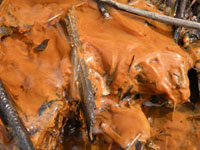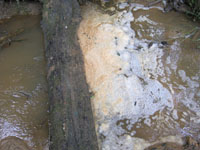
WHY IS THE STREAM SO DARK?
Water in pools, or other slow moving areas, may appear dark brown or black. This is caused by decomposition of organic material. Similar to steeping a tea bag in your mug, leaves and other natural organic material release tannins which can cause a stream to turn a darker color. This is a natural occurrence and is not toxic

WHAT IS THAT ORANGE SLIME?
The fuzzy, bright orange substance seen in the picture to the left is often a type of bacteria. This bacteria takes iron dissolved in groundwater and oxidizes it (a chemical reaction similar to forming rust), drawing energy from the process of turning it into fuzzy orange gunk. Oxidation prevents iron from dissolving in the water and produces either an orange colored slime or an oily sheen, like the picture in the "Bacteria or Petroleum: How to Tell the Difference?" section of this website. This indicates that the stream is partially fed by groundwater.

BACTERIA OR PETROLEUM: HOW TO TELL THE DIFFERENCE?
To distinguish between iron oxidizing bacteria and petroleum, break up the oily sheen on the water with a stick. If the sheen stays broken up in pieces, then it is most likely iron oxidizing bacteria; the same as the orange slime above – just in a different form. Iron oxidizing bacteria is not harmful and may accumulate for several months until it is dislodged by high water flows.
If the sheen goes back together, then it may be a petroleum spill. If you believe it is a petroleum spill, please call the UConn FACOPS at 860-486-3113

SUDSY WATER: NATURAL OR MAN-MADE?
Foam, suds or bubbles in a stream may be the result of a natural process or human pollution. Foam develops in streams when certain substances interact with the water, reducing the surface tension which makes air bubbles on the water. Nature contributes to the creation of foam, suds or bubbles when plants and animals decompose and release a substance that can break down the surface tension of the water.
Over fertilizing your lawn can cause excess plant and algae growth to occur in local streams. The decomposition of this excess growth will lead to an increase in foam, suds and bubbles.
Car washing on hard surfaces, washing machine discharge, sanitary sewer or septic field failure and certain types of industrial discharge from paint and pesticide production can be a source of man-made foam, suds or bubbles in streams.
HOW TO TELL THE DIFFERENCE BETWEEN NATURAL AND MAN-MADE FOAM
Natural sources from decomposition of leaves, twigs or other organic substances:
- Natural foam appears as light tan or brown, but may be white and has an “earthy,” “fishy” or “fresh cut grass” odor.
- Natural foam occurs at many locations along a stream, accumulating on or near the bank, or on other material in the stream.
- Natural foam can be seen in eddies or floating downstream.
- Natural foam increases after rain storms as rainfall transports the decomposed plants to the stream.
- Natural foam can cover large areas and can accumulate in large amounts.
If you see foam, suds or bubbles in a UConn’s Storrs Campus stream that you suspect is a result of a sanitary sewer line break, or if you detect the odor of sewer gas, call the UConn FACOPS at 860-486-3113.
Please call UConn EHS at 860-486-3613 if you suspect the presence of pollution in a surface water stream or pond on the UConn campus.
Man-made sources include yard fertilizing, car washing, washing machine discharge, sanitary sewer or septic field failures:
- Foam from man-made sources is usually white and fragrant or perfumed.
- Foam from man-made sources will accumulate near the source of the discharge.
- Foam from most detergents is biodegradable and will disappear quickly.
- Foam from leaking sanitary sewer lines or septic fields will have a foul odor.
- Foam from man-made sources is likely not related to rain storms.